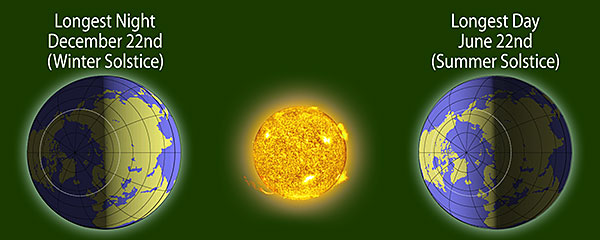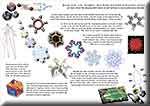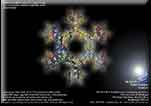|
SCI-FUN's Christmas Card
|
|
The Winter Solstice
|
| The Earth's axis is tilted with respect to the plane of its orbit (which is broadly the plane of the solar system). Ignoring various other effects (which are only important over larger timescales), the tilt is constant, and the axis points in the same direction throughout the year-long orbit (which is approximately circular and constant, again over short timescales).
In the diagram below you can see two points in the Earth's orbit: on the left we see that the axis is tilted away from the Sun (in the Northen hemisphere), and on the right it tilts towards the sun, the angle of tilt being (at present) around 23.5°. Scotland lies at between 55°N and 60°N, approximately, shown by the dotted line. If we now look at the same two positions, but this time from way above the Sun's pole (and with the Earth's size even more exaggerated (and yes, I know that the Sun hasn't changed orientation, but there aren't too many pictures taken from way above the pole....)), we can see that the dotted path does not spend the same amount of time in and out of daylight (below). On the left, which is the Winter Solstice, the arc of daylight is at its shortest; on the right, at Midsummer, the day is at its longest. Winter Solstice tends to occur at around December 22nd/23rd (which will always be the case because we make sure that our calendar doesn't drift, by adding the occasional second to the year length, as necessary). At the intermediate points in the orbit we have the Vernal and Autumnal Equinoxes, in which the day length is exactly half a solar day (give or take...), everywhere on the Earth. |
|
Go back to the Inside-right page
|






